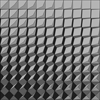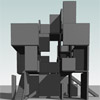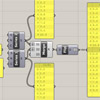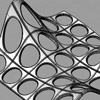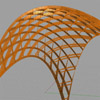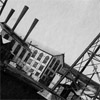Last week, the first-year architectural geometry course was about pattern deformations. Students are expected to familiarize themselves with 2d drawing, transformation, and control point editing commands while trying to design a deformation. After studying regular and semi-regular tessellations of the plane, they are expected to develop reasoning on the rule-based and iterative processes. This also constructed an underpinning for Basic Design‘s “Metamorphosis” study, where they have discussed more conceptual frameworks […]
Posts with the keyword design education
Joseph Bergin‘s pedagogical patterns for computer science education returned my attention to teaching methods I’ve searching for almost five years. Here is a phrase from a paper submitted to pedagogical pattern language project: Most educators and trainers are not taught how to teach. Rather, they often find themselves teaching by accident. Typically, a person with a skill that is in demand, such as a particular programming language, will be asked to teach […]
The logical structure of computer-aided architectural design tools is based on object orientation. New design methodologies named Building Information Modeling or Virtual Building aim to improve this structure by synchronizing the digital object classes with real architectural products. Therefore, CAD becomes smart and parametric. But from the design educator’s point of view, most commercial CAD tools are not useful and too complicated to implement basic spatial concepts. This is the […]
Information Age has been transforming architecture, provoking its theoretical and methodological foundations. We might call this as a paradigm shift or not; it’s obvious that contemporary research fields and built practices lead architectural design into a certain revolution. Mainstream schools of design education are becoming more involved in this revolution, with a common purpose; the need to construct a logical connection between contemporary design theories utilizing methods called popularly as […]
Design computing in architecture is evolved enough to form a more spread out advance, instead of being an alternative way of thinking and practising. Contemporary architectural practice is beginning to push forward such a transformation. This also effects architectural education, that is beginning to focus on digital design paradigm especially at undergraduate level not only in experimental studios, but also in formal education. Design studios however, play an important role […]
Here are some basic references to Grasshopper’s handling of objects. As the most powerful and intuitive part of such Visual Programming Languages is the focus of dataflow, the critical part of it’s education lies at the fundamentals of data tree manipulations. Designers using these tools should understand and predict the type of data trees his/her parametric model would process. Here is the Grasshopper document including these components; [2012_01_10-adding streams] We’ll start […]
The cellular canopy is an anonymous tutorial on the history recording capability of Rhino. I’ve been using a “pedagogical” version of this tutorial as an educational tool on the introduction to Grasshopper and Parametric Modeling for architects. The interesting thing with such exercises is they quickly attract students’ attention to the process of designing, in other words, “designing the design process”; is one of the first things we should emphasize […]
When an educational system does not meet the requirements of a paradigm, new teaching approaches start to emerge. Today, design computing pushes forward a similar transformation on architectural education. Design studio, as the dominant setting for architectural learning, is the center of this transformation. There are numerous researches, experiencing and defining this transformation from various perspectives as “cases”. However as Oxman (2008) highlights, we still need to define a general […]
NURBS surfaces by nature, like four-corner topologies with U and V directions. Şebnem Yalınay Çinici has formulated a tectonic exercise of “Primitive Hut”, which in my point of view is a tough geometric challenge; a subdivision on a real three-corner manifold. That seems very easy at the beginning as both Rhinoceros and Grasshopper are able to create surfaces with three corners, by either lofting, meshing, or edge curve methods. However, those […]
ARCH 362: PARAMETRIC MODELING: Undergraduate Elective Course at İstanbul Bilgi University Faculty of Architecture student exercise: Deniz Yazıcı (YTU/CADU 2008) COURSE BRIEF (2011) Digital paradigm transferred parametric modeling as an alternative conception in architecture, emphasizing a focal shift from the singularity of design artifacts to the explicit and generative process of designing. While architects start to experience the construction of algorithms, computers played an increasingly important role in the adaptation of […]
Design scripting is initially based on secondary syntactic mechanisms that control sequential executions of code. We call this model of computation control flow programming. On the other hand, dataflow represents a widespread alternative to control flow by utilizing concurrent streams of data. Dataflow programming languages are also considered as pedagogical tools in fields where the coders are not expert computer programmers. In the last decade, new parametric modeling tools introduced […]

